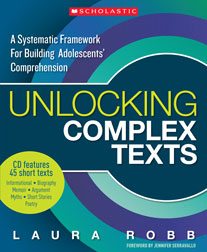Unlocking Complex Texts: A Systematic Framework
Unlocking Complex Texts: A Systematic Framework for Guiding Adolescents’ Comprehension
By Laura Robb
(Scholastic, 2013 – Learn more)
Recently there has been a great deal of discussion (and apprehension) about the Common Core State Standards. Many teachers are concerned whether the new standards will take away from their own research-based best practices and whether this will be a move towards scripted lessons.
Teachers want only the best for their students. As they worry about how this change is going to affect their teaching methodology, questions arise:
• What teaching practices do I have to abandon with this new initiative?
• How can I effectively teach text complexity when I don’t have sufficient resources?
• How can I accomplish this with the limited amount of time I have to teach literacy?
• Will my students lose their self confidence and joy of reading when they are reading complex texts?
 Kudos to Laura Robb and Scholastic Books for publishing Unlocking Complex Texts: A Systematic Framework for Building Adolescents’ Comprehension. This is a book that can help us help our students achieve their best by improving our ability to help middle graders grapple with text complexity.
Kudos to Laura Robb and Scholastic Books for publishing Unlocking Complex Texts: A Systematic Framework for Building Adolescents’ Comprehension. This is a book that can help us help our students achieve their best by improving our ability to help middle graders grapple with text complexity.
Robb’s three-tiered instructional framework of teacher modeling, guided practice, and independent practice scaffolds the students’ learning as they explore texts. The progression of the lessons follows the gradual release model, providing students with the time and practice needed to develop proficiency with the Common Core skills.
It seems that Laura Robb has thought about everything a teacher needs. Each of the seven units is based on genre and built around a theme with five short, complex texts used for teacher modeling and student practice.
In addition, close reading strategies are modeled, and Robb supplies close reading guidelines for students to use as a reference. Hold onto your hats, teachers! Look at what she has to offer!
What’s inside
Texts for each unit contain:
- one anchor text for teacher modeling
- one grade-level text for guided practice
- one below-grade level text for guided practice
- one grade-level text for independent practice and assessment
- one below-grade level text for independent practice and assessment
Ms. Robb’s book is a celebration complete with presents. Each time you read another chapter, look at a resource, or sit back to reflect on her insightful words, you feel as if you have been given another gift – each one just as wonderful as the first.
One of the bonus gifts accompanying this book is a CD that includes 45 short texts for modeling and practice, along with text-specific discussion questions, multiple-choice assessments, writing tasks, student response sheets, assessment tools, and scaffolding charts to help teachers support struggling and reluctant learners.
Another gift is the structure of the lessons. Each of the seven units has the same lesson components:
- A Concept Map: built around a theme or concept to introduce the student to literal or associated meanings of words
- Short Texts: five short texts, outlined above
- Text Complexity Grids: evaluates quantitative and qualitative measures to determine text complexity
- Text-Specific Discussion Prompts: prompts to ask students to make inferences, find themes and central ideas and think deeply about the text
- Multiple-Choice Quiz: five higher level multiple choice questions to provide practice for state tests
- Independent Practice and Assessment: three ways to assess students – summary, word map, or paragraph that explains an idea or supports a claim
- Book List: a list of recommended books
Assessment is crucial to good teaching, not just as an end product but as a goal to drive instruction. I enjoyed reading the assessment strategies at the end of each unit. Robb’s assessments are as valuable as the lessons because they are lessons in themselves.
If you have lots of questions about coping with higher standards and more text complexity, Laura Robb’s book is your life-saving net. When you feel as if you are falling into a bottomless abyss trying to fit in everything while trying to build “fun” into your day, this book is there to help assure you have a soft landing!
Linda Biondi is a fourth grade teacher at Pond Road Middle School in Robbinsville, NJ, and a recipient of several educational grants that infuse a literacy enriched curriculum, along with an understanding of individual learning styles to help students understand bias and patterns of discrimination. She is a Teacher Consultant with the National Writing Project and a participant on the NJ Department of Education Teacher Advisory Panel.
Editor’s note: For more of Laura Robb’s insights into reading, turn to her 2010 book, Teaching Reading in Middle School: A Strategic Approach to Teaching Reading That Improves Comprehension and Thinking, reviewed here by Laura Von Staden.
































